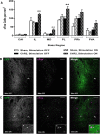Optogenetic Stimulation of Prefrontal Glutamatergic Neurons Enhances Recognition Memory
- PMID: 27147648
- PMCID: PMC4854963
- DOI: 10.1523/JNEUROSCI.2933-15.2016
Optogenetic Stimulation of Prefrontal Glutamatergic Neurons Enhances Recognition Memory
Abstract
Finding effective cognitive enhancers is a major health challenge; however, modulating glutamatergic neurotransmission has the potential to enhance performance in recognition memory tasks. Previous studies using glutamate receptor antagonists have revealed that the medial prefrontal cortex (mPFC) plays a central role in associative recognition memory. The present study investigates short-term recognition memory using optogenetics to target glutamatergic neurons within the rodent mPFC specifically. Selective stimulation of glutamatergic neurons during the online maintenance of information enhanced associative recognition memory in normal animals. This cognitive enhancing effect was replicated by local infusions of the AMPAkine CX516, but not CX546, which differ in their effects on EPSPs. This suggests that enhancing the amplitude, but not the duration, of excitatory synaptic currents improves memory performance. Increasing glutamate release through infusions of the mGluR7 presynaptic receptor antagonist MMPIP had no effect on performance.
Significance statement: These results provide new mechanistic information that could guide the targeting of future cognitive enhancers. Our work suggests that improved associative-recognition memory can be achieved by enhancing endogenous glutamatergic neuronal activity selectively using an optogenetic approach. We build on these observations to recapitulate this effect using drug treatments that enhance the amplitude of EPSPs; however, drugs that alter the duration of the EPSP or increase glutamate release lack efficacy. This suggests that both neural and temporal specificity are needed to achieve cognitive enhancement.
Keywords: AMPAkine; optogenetics; prefrontal cortex; rat; recognition memory.
Copyright © 2016 Benn et al.
Figures






References
MeSH terms
Substances
Grants and funding
LinkOut - more resources
Full Text Sources
Other Literature Sources
Medical
